|
| Landscape - Was the high tide level in Saxon times at Pevensey at about 4.5 metres ? |
|---|
| |
|---|
Table of Contents
|
|---|
|
| |
|---|
| A logical discussion of why the high tide level in early Anglo Saxon times was about 4 to 5 metres ▲ |
|---|
This page is designed to show why I believe that the high tide level was at about the 4 to 5 metres mark in about 450AD
(early Anglo Saxon times)
Lets take an area I know - the Pevensey Levels in Sussex - click here if you would like to see a similar argument
applied to the Wash.
So we will start by looking at the Saxon place names which refer to islands these places are all derived from the Saxon
word æg meaning an island, which has been shown to refer to modern place names starting in eg, ending in ay, et,
ey, ly, ney, sea, sey, ye , is, or contain the snippet eye or island.
So lets take a look at modern Pevensey and see if we can make it and the surrounding island villages into islands by
raising the sea level a metre a time to simulate high tide levels. The following images are derived from Open Streetmap
with the sea level overlays provided by Alex Tingle from http://flood.firetree.net.
|
| |
|---|
This map shows the current sea level ▲
|
|---|
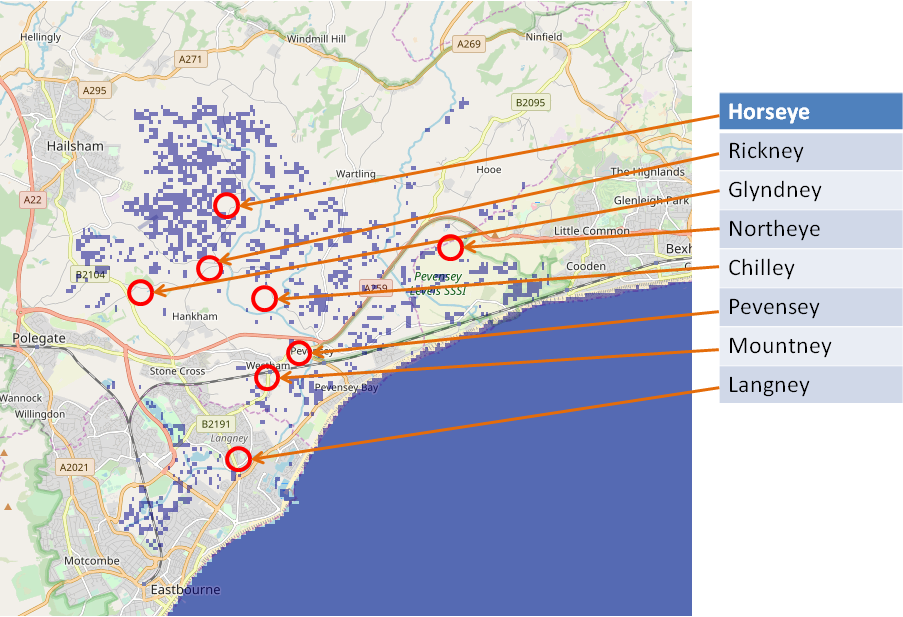
This map is derived from flood.firetree.net and shows the current high tide levels in the Pevensey bay in East
Sussex, England.
|
| |
|---|
This map shows the sea level raised by 1 metre to simulate higher tides ▲
|
|---|
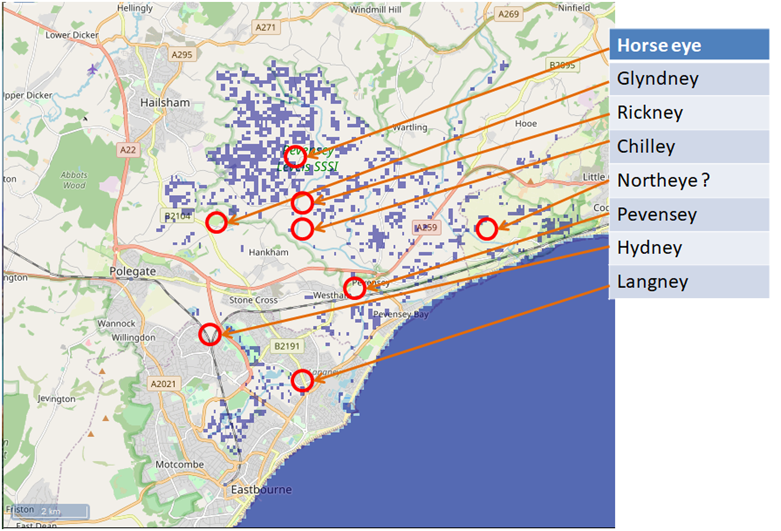
This map is derived from flood.firetree.net and shows the effect of a 1 metre rise in tidal levels in the Pevensey
bay in East Sussex, England.
|
| |
|---|
This map shows the sea level raised by 2 metre to simulate higher tides ▲
|
|---|
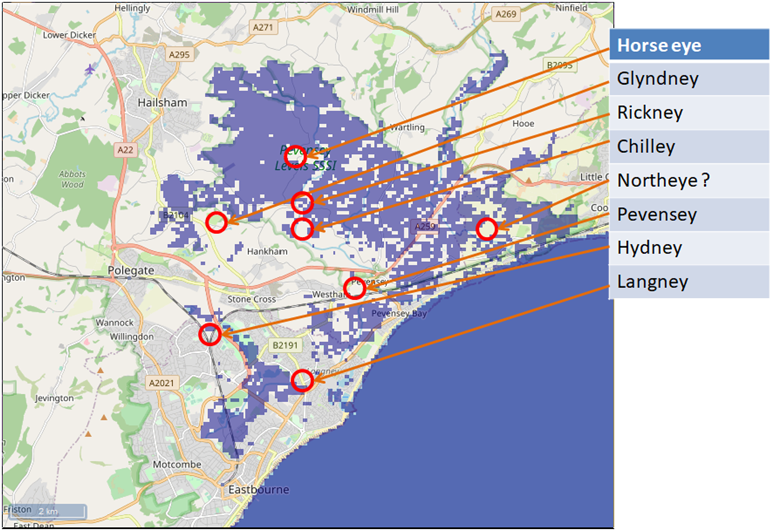
This map is derived from flood.firetree.net and shows the effect of a 2 metre rise in tidal levels in the Pevensey
bay in East Sussex, England.
We don't see any islands at the moment, but there are some interesting possible islands, such as horse eye.
|
| |
|---|
This map shows the sea level raised by 3 metre to simulate higher tides ▲
|
|---|
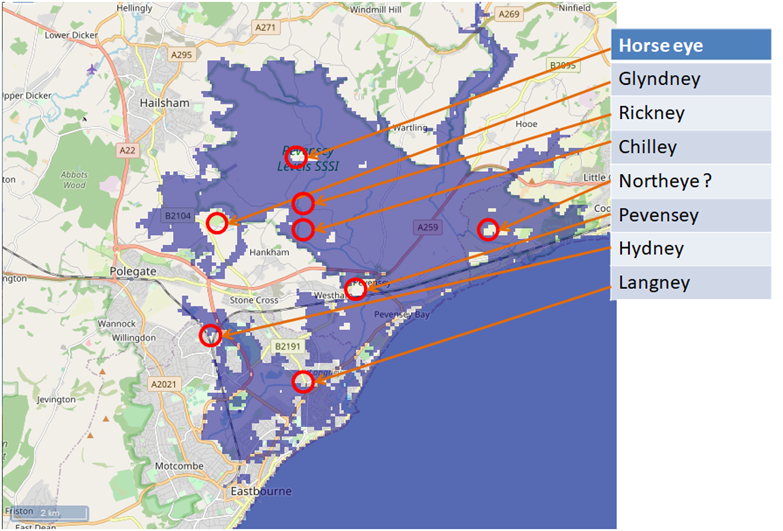
This map is derived from flood.firetree.net and shows the effect of a 3 metre rise in tidal levels in the Pevensey
bay in East Sussex, England.
This is starting to get interesting, there are islands appearing, but Rickney and Chilley look underwater, however
the resolution of the Nasa Data is not fine enough to show the smaller islands.
|
| |
|---|
This map shows the sea level raised by 4 metre to simulate higher tides ▲
|
|---|

This map is derived from flood.firetree.net and shows the effect of a 4 metre rise in high tide levels in the
Pevensey bay in East Sussex, England.
Langney is now an island along with Glyndney, so we are getting somewhere, but Pevensey is not quite an island.
|
| |
|---|
This map shows the sea level raised by 5 metre to simulate higher tides ▲
|
|---|
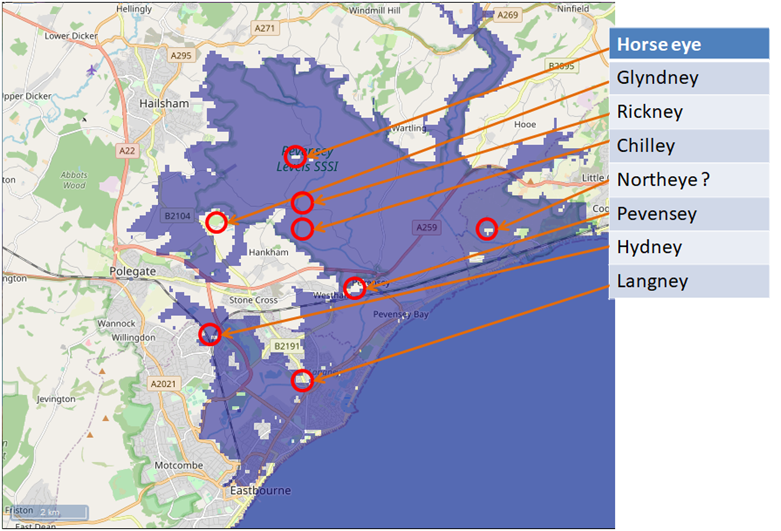
This map is derived from flood.firetree.net and shows the effect of a 5 metre rise in tidal levels in the Pevensey bay
in East Sussex, England.
At last Pevensey is an island as are the other settlements ending in æg.
|
| |
|---|
| Other Evidence ▲ |
|---|
You may not be convinced from a small example in an out of the way spot in Sussex, but click the following links for
further observations that appear to corroborate this theory.
Was the high tide in Saxon times 5 metres
higher ? - the Wash
Roman Locations that have not been identified and roads that
just terminate
|
| |
|---|
| Conclusion ▲ |
|---|
The Saxon definition of an æg would appear to mean a piece of land that
wasn’t flooded at the highest high tide was about 4.5 metres higher than today.
Modern sea defenses and shingle banks have a tendency to hide the actual sea level.
|
| |
|---|
| Translation of the names on the above maps ▲ |
|---|
This list shows our current translation of the locations shown on the above maps.
These come from our snippet theory of settlement names which we believe the Saxons and other earlier settlers used to
describe the location and or use of the place.
Click here to translate a location
The following list of islands from the maps are all Saxon derived names
- Horseye - horse derived from heors - horse / ye derived from æg - an island
- Rickney - rick derived from rics - the reed / ney derived from en æg - en - 'people of' and
æg - 'an island'
- Glyndney - glynd derived from glind - fence of boards or railing / ney derived from en æg - en
- 'people of' and æg - 'an island'
- Northeye -north derived from norþ - north / eye derived from æg - an island
- Chilley -chil derived from ceorl - a freeman / ley derived from el æg - person's island
- Pevensey -pevens derived from fæsten naess - fortress promontory / ey derived from æg - an
island
- Mountney - mount derived from munt - a mountain or mound / ney derived from en æg - en -
'people of' and æg - 'an island'
- Langney -lang derived from læng - long / ney derived from en æg - en - 'people of' and æg -
'an island'
|